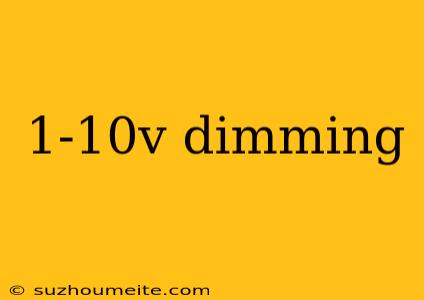1-10V Dimming: Understanding the Basics
What is 1-10V Dimming?
1-10V dimming is a type of lighting control method that uses a low-voltage signal to dim lamps or light sources. It is a popular method used in various applications, including commercial and residential buildings, theaters, and studios. In this method, a controller sends a voltage signal between 1 and 10 volts to the driver or ballast of the lamp, which then adjusts the brightness of the light accordingly.
How Does 1-10V Dimming Work?
The 1-10V dimming system consists of three main components:
Controller
The controller is the device that sends the voltage signal to the driver or ballast. It can be a wall-mounted dimmer, a remote control, or a computerized lighting control system.
Driver or Ballast
The driver or ballast is the device that powers the lamp and receives the voltage signal from the controller. It adjusts the power output to the lamp based on the received signal, thereby controlling the brightness of the light.
Lamp
The lamp is the light source that is being controlled. It can be an LED, fluorescent, or HID lamp.
How to Wire a 1-10V Dimming System
Wiring a 1-10V dimming system is relatively simple. Here's a step-by-step guide:
- Connect the controller to the driver or ballast using a low-voltage cable.
- Connect the driver or ballast to the lamp.
- Power on the system and adjust the brightness using the controller.
Advantages of 1-10V Dimming
1-10V dimming offers several advantages, including:
- Energy Efficiency: Dimming reduces energy consumption, leading to cost savings and a reduced carbon footprint.
- Flexibility: 1-10V dimming allows for smooth, continuous dimming, making it ideal for applications that require precise brightness control.
- Easy Installation: Wiring a 1-10V dimming system is relatively simple and straightforward.
Common Applications of 1-10V Dimming
1-10V dimming is commonly used in various applications, including:
- Theaters and Studios: To create precise lighting effects and adjust brightness levels for different scenes.
- Commercial Buildings: To control lighting levels in offices, conference rooms, and common areas.
- Residential Buildings: To create ambiance and adjust lighting levels in living rooms, dining rooms, and bedrooms.
Conclusion
1-10V dimming is a popular and effective method of controlling lighting levels in various applications. Its ease of installation, flexibility, and energy efficiency make it an ideal choice for many users. By understanding the basics of 1-10V dimming, you can easily implement this technology in your own projects and achieve precise lighting control with ease.
